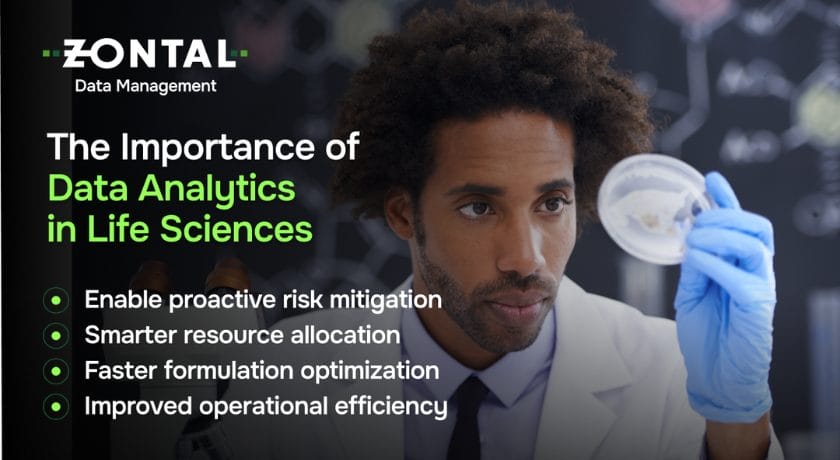Data Analytics in Life Sciences: Benefits, Challenges & FAQs

Data Analytics in Life Sciences Explained: Key Takeaways
- Analytics platforms help life sciences teams streamline R&D, boost traceability, and speed up discovery, without compromising compliance or data integrity
- Key challenges in life sciences data analytics include data silos, compliance hurdles, and cross-lab integration
- When choosing a data analytics partner in life sciences, look for one that understands your scientific workflows and can scale with your needs
The global life science analytics market is projected to reach USD 16.33 billion by 2030.
This is fueled by the push to standardize and integrate data from genomics, research systems, and real-world sources, enabling seamless data exchange across labs.
For life sciences teams, this shift enables faster discovery, better collaboration, and smarter use of data to drive innovation and gain a competitive edge.
Understanding what’s driving this growth and what’s holding it back is key to making the most of your data analytics strategy.
By the end of this guide, you will:
- Learn how data analytics accelerates discovery, improves efficiency, and supports decision-making in life sciences
- Identify the key barriers to effective life sciences data analytics
- See how ZONTAL can help unify, standardize, and maximize the value of your scientific data
Break down data silos with ZONTAL.
Data Analytics in Life Sciences: How It Drives Innovation, Efficiency & Smarter Decision-Making
Data analytics is redefining life sciences by helping teams discover new molecules faster, use resources more wisely, and spot risks before they become problems.
It’s a core driver behind the increasing adoption of life sciences analytics platforms across research and manufacturing.
1. Proactive Risk Mitigation in Manufacturing
In biotechnology, effective risk management means anticipating, not reacting to, process disruptions.
Predictive analytics allow early detection of anomalies across sourcing, formulation, and production by monitoring parameters and supply chain variables in real time.
This data-driven foresight, enabled by life sciences analytics, does the following:
- Reduces material waste
- Prevents batch failures
- Ensures continuous quality and compliance at scale
2. Smarter R&D Budgeting and Resource Allocation
Advanced life sciences data analytics is transforming R&D financial planning by moving beyond static cost tracking.
Instead of relying on historical spend or generic forecasts, modular applications analyze:
- Experimental throughput
- Reagent use
- Instrument load
- Workforce efficiency
This visibility helps align budgets with actual demand, prioritize high-impact research, and lower spend on low-value programs, without compromising scientific rigor.
3. Accelerating Molecule Discovery and Formulation Optimization
AI-powered analytics accelerates compound identification, efficacy prediction, and formulation design.
Trained in structure libraries, assay data, and physicochemical profiles, algorithms surface viable candidates faster than traditional wet-lab testing.
Such insights pave the way for:
- Repurposing legacy compounds
- Simulating drug-excipient interactions
- Optimizing stability, reducing experimental cycles and speeding progress from bench to production
4. Driving Operational Efficiency at Scale
Operational efficiency is key to scaling scientific innovation without driving up costs.
With the right analytics tools, life sciences teams can streamline processes, automate repetitive tasks, and spot inefficiencies across labs, systems, and teams.
When systems are integrated, analytics becomes a unifying force, making it easier to:
- Monitor performance in real time
- Eliminate manual data entry and duplication
- Boost throughput without adding headcount. Improve coordination between R&D, QA/QC, and manufacturing.
The result? Faster and leaner operations that deliver more value, without compromising scientific quality.

Data Analytics in Life Sciences: 4 High-Value Use Cases
Data is doing more than just sitting in databases; it’s driving faster decisions through life sciences data analytics.
These four use cases show how:
1. Target Identification and Validation
Data analytics speeds up the search for viable drug targets by uncovering patterns in gene expression, protein interactions, and disease pathways.
Machine learning models can sift through massive omics datasets to reveal connections that might otherwise be missed, helping scientists identify and validate targets more accurately.
2. Compound Screening and Selection
AI models trained on historical assay data, compound libraries, and toxicity profiles can rapidly predict a molecule’s efficacy and risk.
Instead of physically screening millions of compounds, teams can digitally prioritize top candidates for lab validation.
This cuts early R&D time and cost while improving hit quality and lead optimization outcomes.
3. Genomic Pattern Recognition
Advanced analytics enable scalable interrogation of whole-genome and transcriptome data.
Purpose-built algorithms identify genetic variants, expression patterns, and mutational hotspots associated with disease mechanisms.
These insights support earlier identification of molecular targets and enhance the predictive power of preclinical modeling within life sciences analytics workflows.
4. Immediate Quality Monitoring
Analytics platforms continuously track data from lab instruments and workflows, making it easier to spot anything unusual, like shifts in temperature, pH, calibration, or reagent performance.
This proactive oversight allows teams to respond immediately, preserving data integrity, ensuring regulatory compliance, and minimizing costly rework in life sciences environments.
Turn complex lab data into actionable insights.
What’s Holding Back Data Analytics in Life Sciences
Even with all its potential, data analytics in life sciences often gets held back by disconnected systems, tough compliance requirements, and the struggle to integrate and reuse data across teams.
These common challenges are worth paying attention to:
1. Data Silos and Legacy Systems
A lot of life sciences data is trapped in outdated systems or scattered across disconnected teams and tools, making it hard to get a complete view or run meaningful analytics.
Legacy systems and inconsistent formats slow everything down. Solving this starts with adopting systems that can communicate seamlessly and aligning teams around shared data standards.
2. Data Privacy and Compliance
As life sciences companies expand their digital operations, staying on top of data integrity and regulatory compliance is getting harder. A recent global life sciences benchmarking report called out both as major challenges across the industry.
And it’s not just about patient data; genomic sequences, lab records, and even metadata can carry sensitive information.
That’s why analytics platforms need to be both insightful and compliant, offering:
- Strong encryption
- Controlled access
- Full auditability to protect data and maintain trust
3. Integration Across Labs and Organizations
Life sciences research often involves multiple labs, partners, and platforms, each with its own systems, data standards, and workflows.
This fragmentation:
- Creates barriers to collaboration
- Delays decision-making
- Limits the reuse of valuable data
Unlocking full value requires seamless integration across ELNs, LIMS, instruments, and sites.
When systems are connected and data is standardized, teams can collaborate more effectively, reduce redundancy, and accelerate discovery across the organization.
4. Reproducibility and Model Reliability
Scientific results must be reproducible. But in life sciences, analytics models used for target prediction, compound screening, or process optimization often struggle with consistency.
That’s because they’re frequently trained on data that’s incomplete or scattered across systems.
To trust these models, teams need to run thorough tests to confirm their predictions are accurate and reliable.
But without well-curated, consistent datasets, it’s hard to validate model performance or scale insights across experiments and workflows.
5. Skill Shortages
Life sciences analytics requires a specific mix of expertise: deep scientific knowledge, strong data analysis skills, and the technical ability to work with complex systems and tools.
Many teams lack the in-house expertise to manage complex models or workflows, slowing adoption and reducing impact. The talent gap remains a major barrier to building analytics maturity.

How To Choose the Right Data Analytics Partner in Life Sciences
Choosing the right data analytics partner in life sciences means finding a platform and team that understands your scientific processes, handles complex data types, and supports the compliance standards your organization needs to meet.
Thinking about who to trust with your data? Consider these key traits:
1. Make Sure They Understand Your Science and Operations
A capable analytics partner should understand the unique context of life sciences and how data flows across research, regulatory, and manufacturing settings, and the constraints that come with it.
ZONTAL is designed with this environment in mind, supporting experimental data management, metadata standardization, and long-term data accessibility.
Our platform is built to align with how scientific teams actually work, rather than forcing generic workflows into specialized settings.
2. Ensure They Can Scale With You
Data volumes in life sciences grow fast, especially with high-throughput experiments, multiple ELNs, and global lab networks.
ZONTAL supports cloud-based scalability and seamless integration across instruments, LIMS, and ELNs, which helps organizations manage increasing complexity without overhauling their infrastructure.
It’s suited for environments where flexibility and interoperability are essential for growth.
3. Don’t Compromise on Compliance and Data Security
Regulatory expectations don’t just apply to clinical data. Lab-generated data, such as genomic sequences, analytical results, and method documentation, can also fall under frameworks like FDA 21 CFR Part 11.
ZONTAL addresses these by providing secure archiving, access controls, and audit trails designed for traceability and long-term preservation, helping teams stay compliant without adding unnecessary overhead.
Get More From Your Data With ZONTAL’s Life Science Analytics
In life sciences, data is one of your most valuable assets. But too often, it’s locked away in disconnected systems and scattered across teams.
To get real value from it, organizations need to break down silos, optimize workflows, and apply analytics that lead to actionable insights.
ZONTAL’s Life Science Analytics is purpose-built to solve these challenges.
Whether you’re optimizing R&D workflows, enhancing data accessibility and implementing data preservation, or embedding AI into your lab environment, ZONTAL integrates seamlessly with your existing systems and scales with your needs.
Why choose ZONTAL?
- Accelerate data transformation in labs
- Standardize and harmonize scientific data
- Improve reproducibility, traceability, and insight quality
- Enable smarter decisions with embedded analytics
Unify fragmented systems and unlock deeper data insights
Data Analytics in Life Sciences: FAQs
What are data analytics in life sciences?
In life sciences, data analytics can help turn complex biological and lab data into clear, actionable insights.
That means faster drug discovery, smoother lab operations, and better decision-making across research and manufacturing.
How is AI improving life sciences data analytics?
AI is transforming how life sciences teams work with complex datasets, making it faster and easier to extract meaningful insights. It’s helping teams:
- Accelerate data processing across high-volume research environments
- Improve the accuracy of predictions in experimental design and modeling
- Advance innovation in areas like mRNA development
- Detect patterns in large-scale biological data that traditional methods often miss
What are the main challenges in implementing data analytics in life sciences?
The biggest hurdles include:
- Scattered and siloed data systems
- Complex integration across platforms and tools
- Strict regulatory and compliance requirements
- Inconsistent or poor data quality
- Shortage of specialized data and domain expertise
- Resistance to changing established workflows and processes
Wondering how ZONTAL can future-proof your data infrastructure?
 >
> 

